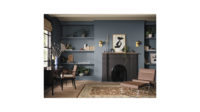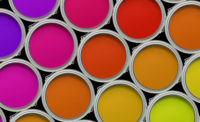Automotive Color Trends - PPG Report: Global Vehicle Color Popularity Starting to Shift
Black,
white close gap in North America; blue gains global importance

Silver has once again dominated as the world’s most popular car color but other shades are gaining ground, especially in North America. This is according to annual automotive color popularity data released by PPG Industries.
While silver is still the most popular car color globally – capturing 20 percent in North America, 35 percent in Europe and 37 percent in Asia Pacific – white and black are close on its heels in North America, tying silver in popularity in certain vehicle segments.
In North America, silver (20 percent) was followed closely by white (18 percent) and black (17 percent – up two percentage points from last year). These were followed by red (13 percent), blue (12 percent), naturals (9 percent), other/niche market colors (7 percent) and green (4 percent).
“Although silver is the most popular car color overall, we’re not dealing with the same old silvers anymore,” said Jane E. Harrington, PPG Manager, Color Styling, Automotive Coatings. “With advances in technology and design, silver shades continue to evolve with the incorporation of hue shifts, color tints, aluminum flake size and appearance. Silver, along with black and white, is offered on every vehicle line as part of the core color palette, which also increases its popularity.”
Despite the steady popularity of these neutral shades, Harrington said she believes the automotive future is becoming more multicolored.
“We’re seeing more abundant color use at major auto shows as consumers start to show increased interest in vivid, intense shades,” Harrington said. “Today’s consumers are in tune with brand images, and they see premium colors on everything from cell phones to washers and dryers. Good color design is not considered a bonus anymore, it’s an expectation.”
In Europe, silver (35 percent) was followed by black (24 percent), blue (12 percent), white (11 percent), red (8 percent), naturals (6 percent), green (3 percent) and other/niche colors (1 percent).
In the Asia Pacific region, silver (37 percent) was followed by white (14 percent), black (13 percent), blue (11 percent), red (8 percent), naturals (7 percent), other/niche colors (6 percent) and green (4 percent).
Looking to the future, the colorists of the PPG Global Design and Color Marketing Team have developed more than 130 color concepts for automakers’ consideration for the 2011-2012 model years. The collection, which emphasizes PPG’s focus on exterior and interior colors, is currently being presented to automakers during PPG’s global color show, called “Influences.”
A sampling of new colors in the Influences collection includes: Lights Out, a very deep, dark blue with the added sparkle of glass flake; Bling, a pale gold with a subtle color change like a great piece of gold jewelry; Visionary Violet, a very dark violet with a brilliant sparkle that is influenced by interior design and the youth fashion market; and Split & Peel, a fresh pale-banana yellow with a creamy look.
While many future colors were influenced by the environment – resulting in a batch of natural-looking shades and textures – one of the biggest stories of PPG’s show is the emerging importance of the color blue.
“For the second consecutive year, blue was the favorite color selected by the 1,200 potential car buyers PPG polled at the North American International Auto Show in Detroit last January,” Harrington said. “Blue is a very versatile color for automotive and can complement any vehicle’s brand or style.”
Blue is being pegged as the most vital color focus for the global automotive industry going forward.
“Blue will be the new major color area for the coming years,” said Reiner Mueller-Koerber, PPG Manager, Color Styling, Europe. “Dark blues have the potential to replace traditional dark grays and blacks, while lighter blues can be seen as variations of tinted silvers. Blue has the ability to cover the spectrum, from rich and deep to clean and fresh.”
Mi Hwa Lee, Color Stylist, PPG Korea, said, “Although silver, white and black are still overwhelmingly popular, it is obvious that many blue tones are increasing in popularity, especially in China. For that reason, various tones of blue in hues from medium to dark are being developed specifically for the Asia Pacific region.”
In addition to color trend forecasting, PPG is creating new paint technologies that enhance automotive design, exceed appearance requirements and help automakers differentiate their brands. At this year’s Influences show, the focus is on achieving special effects, whether by simple formulation or extreme processing techniques.
As part of Influences, PPG highlights new techniques and materials that stimulate visual expectations and create complex shades, as well as technically advanced functional effect colors. For example, designers are creating new color spaces by incorporating highly color-saturated and durable ANDARO™ nanopigment technology by PPG into traditional and alternative OEM coating systems.
“Combining form and function in a decorative coating is a challenge that can only be met with imagination and technical skills,” said Jerry R. Koenigsmark, PPG Manager of Color Design, North America automotive coatings. “As we move ahead, we continue to challenge ourselves and offer our customers forward-thinking ideas in color design.”
On the forefront of innovation in decorative and protective coatings and environmental application concerns since 1924, PPG helps automakers advance coatings technologies and application processes.

Silver has once again dominated as the world’s most popular car color but other shades are gaining ground, especially in North America. This is according to annual automotive color popularity data released by PPG Industries.
While silver is still the most popular car color globally – capturing 20 percent in North America, 35 percent in Europe and 37 percent in Asia Pacific – white and black are close on its heels in North America, tying silver in popularity in certain vehicle segments.
In North America, silver (20 percent) was followed closely by white (18 percent) and black (17 percent – up two percentage points from last year). These were followed by red (13 percent), blue (12 percent), naturals (9 percent), other/niche market colors (7 percent) and green (4 percent).
“Although silver is the most popular car color overall, we’re not dealing with the same old silvers anymore,” said Jane E. Harrington, PPG Manager, Color Styling, Automotive Coatings. “With advances in technology and design, silver shades continue to evolve with the incorporation of hue shifts, color tints, aluminum flake size and appearance. Silver, along with black and white, is offered on every vehicle line as part of the core color palette, which also increases its popularity.”
Despite the steady popularity of these neutral shades, Harrington said she believes the automotive future is becoming more multicolored.
“We’re seeing more abundant color use at major auto shows as consumers start to show increased interest in vivid, intense shades,” Harrington said. “Today’s consumers are in tune with brand images, and they see premium colors on everything from cell phones to washers and dryers. Good color design is not considered a bonus anymore, it’s an expectation.”
In Europe, silver (35 percent) was followed by black (24 percent), blue (12 percent), white (11 percent), red (8 percent), naturals (6 percent), green (3 percent) and other/niche colors (1 percent).
In the Asia Pacific region, silver (37 percent) was followed by white (14 percent), black (13 percent), blue (11 percent), red (8 percent), naturals (7 percent), other/niche colors (6 percent) and green (4 percent).
Looking to the future, the colorists of the PPG Global Design and Color Marketing Team have developed more than 130 color concepts for automakers’ consideration for the 2011-2012 model years. The collection, which emphasizes PPG’s focus on exterior and interior colors, is currently being presented to automakers during PPG’s global color show, called “Influences.”
A sampling of new colors in the Influences collection includes: Lights Out, a very deep, dark blue with the added sparkle of glass flake; Bling, a pale gold with a subtle color change like a great piece of gold jewelry; Visionary Violet, a very dark violet with a brilliant sparkle that is influenced by interior design and the youth fashion market; and Split & Peel, a fresh pale-banana yellow with a creamy look.
While many future colors were influenced by the environment – resulting in a batch of natural-looking shades and textures – one of the biggest stories of PPG’s show is the emerging importance of the color blue.
“For the second consecutive year, blue was the favorite color selected by the 1,200 potential car buyers PPG polled at the North American International Auto Show in Detroit last January,” Harrington said. “Blue is a very versatile color for automotive and can complement any vehicle’s brand or style.”
Blue is being pegged as the most vital color focus for the global automotive industry going forward.
“Blue will be the new major color area for the coming years,” said Reiner Mueller-Koerber, PPG Manager, Color Styling, Europe. “Dark blues have the potential to replace traditional dark grays and blacks, while lighter blues can be seen as variations of tinted silvers. Blue has the ability to cover the spectrum, from rich and deep to clean and fresh.”
Mi Hwa Lee, Color Stylist, PPG Korea, said, “Although silver, white and black are still overwhelmingly popular, it is obvious that many blue tones are increasing in popularity, especially in China. For that reason, various tones of blue in hues from medium to dark are being developed specifically for the Asia Pacific region.”
In addition to color trend forecasting, PPG is creating new paint technologies that enhance automotive design, exceed appearance requirements and help automakers differentiate their brands. At this year’s Influences show, the focus is on achieving special effects, whether by simple formulation or extreme processing techniques.
As part of Influences, PPG highlights new techniques and materials that stimulate visual expectations and create complex shades, as well as technically advanced functional effect colors. For example, designers are creating new color spaces by incorporating highly color-saturated and durable ANDARO™ nanopigment technology by PPG into traditional and alternative OEM coating systems.
“Combining form and function in a decorative coating is a challenge that can only be met with imagination and technical skills,” said Jerry R. Koenigsmark, PPG Manager of Color Design, North America automotive coatings. “As we move ahead, we continue to challenge ourselves and offer our customers forward-thinking ideas in color design.”
On the forefront of innovation in decorative and protective coatings and environmental application concerns since 1924, PPG helps automakers advance coatings technologies and application processes.
Looking for a reprint of this article?
From high-res PDFs to custom plaques, order your copy today!






